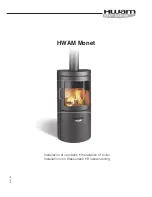
THE FUEL
12
Chapter 3
THE FUEL
THE PELLETS
Pellets are realised by subjecting wood shavings i.e. the rejects of pure wood (without paint) sawmill,
carpenter products and products from other activities connected to working and transforming wood, to
very high pressures.
This type of fuel is absolutely ecological as no glues are used to hold it together. In fact, the compactness of
the pellets is guaranteed through time by a natural substance that is found in wood: lignite As well as being
an ecological fuel, as wood residues are made the most of, the pellet also has technical advantages.
Pellet density is 650 kg/m3 and water content equal to 8% of its weight. For this reason it is not necessary
to age the pellet to obtain a suffi
ciently adequate heat yield (on the contrary, wood has 15% humidity after
about 18 months’ ageing).
To guarantee combustion without problems, the pellets must be kept in a dry place. The diameter goes
from a minimum of 5mm to a maximum of 8mm. Extrafl ame recommends using 6mm pellet.
PELLET FEEDING
During fi rst product use, feed the pellet inside the tank, as illustrated in the fi gure, until completely full.
Pellet tank
1. Open the tank lid
2. Empty pellet inside the
tank
It is important to periodically check the residue pellet inside the tank to avoid it fi nishing
completely, which results in the boiler switching off .
WARNINGS
The use of expired pellets or any other unsuitable material can damage certain boiler components and
jeopardise its correct functioning: this can determine the invalidity of the warranty and the relative
responsibility of the manufacturer. Extrafl ame invites the user to use pellet in compliance with the described
features and the Standards in force.
fi gure 3.1
fi gure 3.2
fi gure 3.3













































